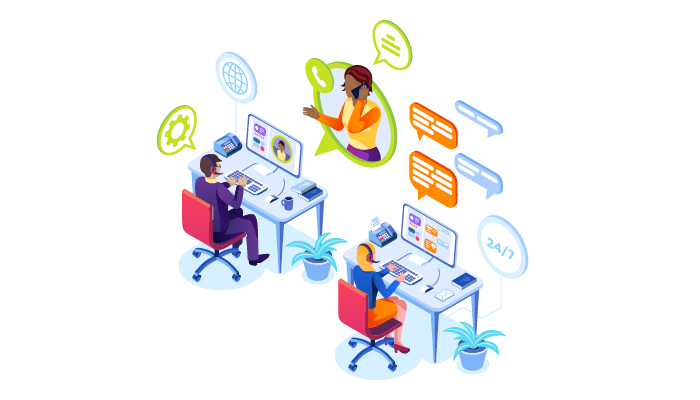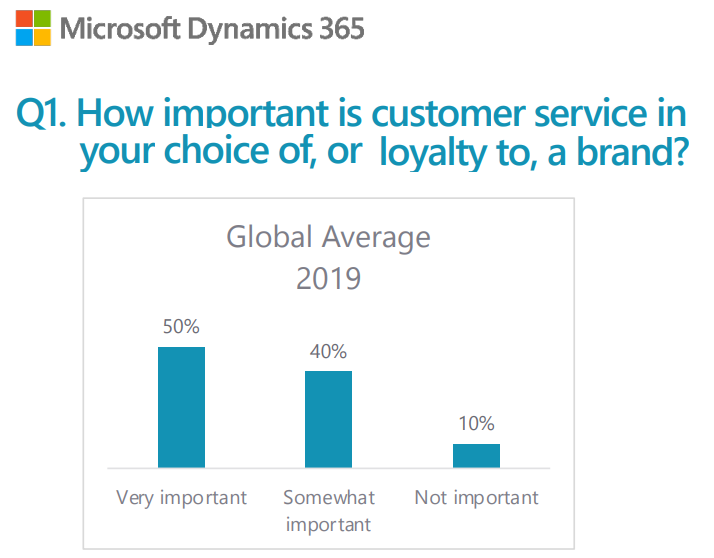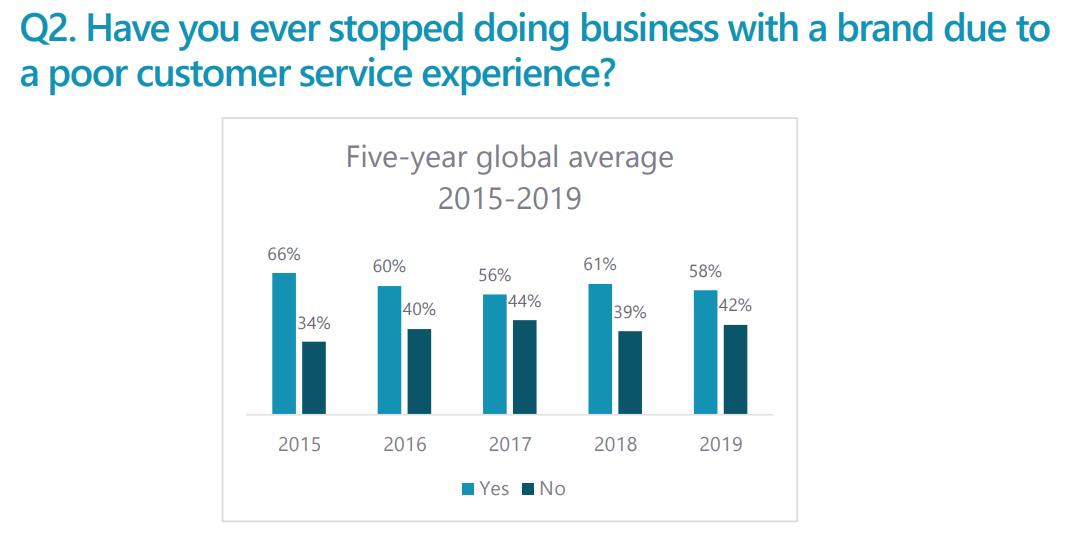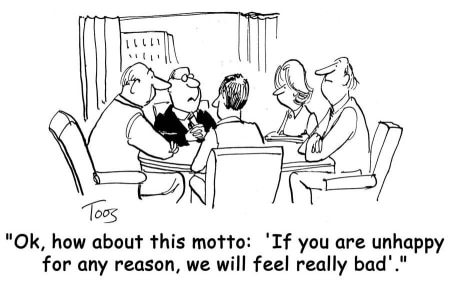
Exceptional customer service—it’s more than just a concept a business should lean into for the sake of reputation, it’s the fine line between success and failure.
That might seem like a bold claim, but it’s true. You could have a fantastic product and a pure vision in mind for bettering your customers’ lives, but without devotion to constant improvement and betterment of your customer service practices, you’ll more than likely lose customers as a result.
In clearer terms, investing in customer service best practices is the foundation of long-term success for your business, no matter your niche, size, or industry.
According to Microsoft's 2019 Global State of Customer Service, about 90% of survey respondents will use customer service as a factor in deciding whether or not to do business with a company.
 (Source)
(Source)
That same research states that about 58% of American consumers in 2019 said they will switch companies because of a poor customer service experience.
 (Source)
(Source)
This research begs the question—if customer service is so important to a company’s success, why do so many businesses seem to fail in this department?
Often, customer service failures have less to do with a malicious intent to be unhelpful to customers and, more often than not, relate to a company’s core understanding of customer service, turning a blind eye to tools that could improve a customer’s experience, and ignorance about what customer services best practices can actually do for your valued customers.
So, how can a company like yours ensure that you’re not doomed to repeat these failures?
That’s precisely what this article is all about.
In this article, you’ll learn a few things that we believe are immensely helpful to every company’s journey toward better customer service. We’ll dive into concepts that:
- Outline what exceptional customer service is in the first place
- Discuss the importance of exceptional customer service for business longevity
- Explore best practices that your company can integrate into your current customer service repertoire
- Explain software that can best help you tackle your customer service weaknesses
Changing the way you think about customer service is the first step toward providing the best customer service possible to your target audience. So, let’s get started with the basics.
Customer Service as the Core of Your Business: Why Customer Service Best Practices Matter
It’s one thing to say your “customers matter”—it’s another believe it. Aside from the basic, altruistic truth that people matter in general (we’re not denying that whatsoever), what your customers think about you and how they feel about you play an enormous role in your company’s success.
Exceptional customer matters for a lot of reasons and in a lot of different contexts. Customer service typically comes into the equation after a mistake (actual or alleged) has been made. Obviously, this isn’t the sole purpose of customer service, but this is the department that deals with consumers at their favorable.
According to Salesforce Research, if a company’s customer service is excellent nearly 80% of consumers will choose to do business with the company again after a mistake is made. Further, 93% of customers are likely to make repeat purchases with companies who offer excellent customer service from the start (mistakes or not).
But that’s not all. Excellent customer service has many benefits that play into nearly every aspect of your business—from customer acquisition and retention to reliable feedback and competitive advantages.
Retaining Customers is Cheaper than Customer Acquisition
By this, we don’t mean you should stop focusing on acquiring new customers—but it is important to note that customer retention is far more affordable than customer acquisition. In fact, various studies have shown that investing in tactics to try and recruit new customers is between 5-25 times more expensive than retaining existing ones.
Investing in exceptional customer service best practices is one of the foundational ways to keep your current customers.
Why?
Because it can decrease the rate by which you need to acquire new customers to make up for the converted customers who opt for other companies after a bad customer service experience.
The fact of the matter is that keeping current customers happy and buying is less expensive than chasing down new ones, and exceptional customer service is a large part of making that happen.
Salesforce Research supports this concept, saying that 89% of consumers are more likely to make another purchase after a positive customer service experience.
Your Customer Service is a Representation of Your Brand, Mission, and Message
No matter what industry you’re in, how your brand is perceived is a big deal. And if part of that perception is poor customer service then, let’s face it, your company is in trouble.
Your customer service team is a big piece of your branding puzzle. An exceptional team with exceptional customer service best practices has more control over your brand’s perception than other aspects of your branding, like your social media, your digital marketing, and your advertisements.
Why?
Because this is an experience they’re dealing with first-hand. Customers will speak directly (hopefully, anyway) with customer service representatives—and those experiences will set the tone for how consumers feel about your brand and how they interpret your company’s outlook on customer satisfaction.
Satisfied Customers Refer New Customers Your Way
Remember the stats we shared about acquiring new customers? With this in mind, wouldn’t it be extra beneficial if you had new customers interested in working with you or purchasing from you without having to put in that acquisition money?
In theory, that sounds great, doesn’t? In practice, this is possible with investment into better customer service as satisfied customers who feel valued and appreciated are far more likely to refer other customers to you.
According to Qualtrics XM Institute, a good customer service experience heavily impacts recommendations—so, consumers who rate a company’s service as “good” are 38% more likely to recommend that company.
In other words, the more you invest in exceptional customer service for your current customers, the more likely you are to have new customers referred to you by those satisfied customers.
Good Customer Service Leads to Better Customer Loyalty
It’s no secret that providing great customer service leads to improved customer satisfaction, both of which play a role in customers’ choices and their brand loyalty. In fact, about 96% of customers say that customer service will play an important role in their decision to become or remain loyal to a brand.
The fact of the matter is, customers are savvy—they won’t settle for brands that won’t meet (and honestly exceed) their customer service expectations. Customers want to be loyal to brands that change with them, they want brands that make efforts (proactively) to understand them.
This makes sense when coupled with the research that shows that 70% of the customer’s journey is based on how the customer feels they’re being treated.
Customer Service is an Opportunity for Valuable Client Insight
How you feel about your brand is unimportant when compared to how your customers perceive your brand.
You could think you’re doing right by your customers and speculate no other customer service department is offering the type of assistance you are—but none of that matters if your customers don’t agree.
Customer service teams create unique opportunities to garner real feedback and gauge actual interpretations of your company. Are your customers satisfied with your products? Do your consumers feel like they’re valued? Do customers actually feel like your customer service team is helping—proactively and after the fact?
Surveying your customers through your customer service engagement is a simple, streamlined way to better understand how your audience perceives your brand, your products, and your services.
Customers Expect (& Deserve) High-Quality Support
Customer service is more important than ever. Not only do customers wish for better service in this day in age, they actually demand it.
In fact, more than half of the consumers surveyed in a research study (58%) said that their customer service expectations are higher today than they were a year ago—and that percentage is expected to continue growing.
Further, nearly 70% said they’d switch brands (with little hesitation) if they felt like they were being treated like a number instead of an individual—more evidence that high-quality customer service is increasingly becoming more important.
Exceptional Customer Service Creates a Competitive Advantage
Throwing in the towel on your customer service is the metaphorical equivalent of saying “I’m fine with being second best in my industry.”
The fact of the matter is, companies can provide superior products and services, but without premium customer service, customers are willing to walk.
It’s likely that customers will refuse to work with a brand after just one poor customer service experience.
With that in mind, you can see how offering consistent, cohesive customer assistance can make all the difference when it comes to edging out the competition. Right?
Best Practices for Providing Exceptional Customer Service
Understanding the concept of customer service is one thing—delivering exceptional customer service through tried-and-true best practices is another. It’s not enough to just claim you care about your customers, it’s something your business needs to actually deliver on.
Your customers will know the difference between sub-par service and exceptional customer care, so it’s not something your business can fake.
Exceptional customer service means investing in best practices that make your customers feel valued while actually solving problems—doing all of this with a pleasant, helpful attitude is a must, too.
If you’re not quite sure where to start when it comes to optimizing your customer service best practices, consider this list to get the ball rolling.
These tips have been devised to help you with a long-term plan for customer service best practices, but note that excellent customer service is an evolving process that changes with consumers’ needs, expectations, the availability of new technology, and more.
1. Improve First Touch Resolution
One of the most streamlined ways to improve your customer service procedures immediately is to improve first touch resolution for any customer support issues. Resolving a customer’s issue quickly and efficiently is the ultimate goal of customer service, and how you handle first contact resolution (FCR) will play an important role in your overall customer service procedure.
Poor FCR can result in high customer support staffing costs, higher churn rates, lower customer loyalty, and longer first response times—all of which contribute to a drop in customer satisfaction.
Improving your first touch resolution through actionable steps can help you improve your customer support efforts, leading to better service. Here are some recommendations for doing so:
- Analyze your delayed responses or action items that weren’t resolved on the first touch. What went wrong?
- Let the above data guide you—how can you better collect all the information you’ll need upfront, every time.
- Train your team and equip them with what they need to get the job done. Focus on product training, customer service training, and skill training.
- Don’t let your customer support team deal with FCR until you can provide them with the technology they need to resolve issues on their first touch. Ensure customer data is accessible, equip them with supportive resources, and ensure ticket routing works seamlessly.
With these points in mind, it’s more important than ever to create a cohesive portal where your customer service requests can be best organized, tracked, and analyzed.
If you’re not quite sure how to create this type of system, investing in knowledge base software could be the ticket. With comprehensive knowledge base software, or platforms like Salesforce for customer service, you’re able to centralize service requests, organize helpful content and resources, and create streamlined accessibility to all necessary information.
2. Provide Self-Service Options
It might seem hard to believe, but your customers don’t want to always talk to someone directly to get their problem solved. In fact, research shows that 81% of customers try to take care of matters themselves before opting to reach out to a customer service representative. Further, research also shows that over 70% of customers would prefer the ability to solve their customer service issues on their own.
The moral of this research? Providing cost-effective, seamless self-service is a solid plan for pleasing your customers.
To assist customers in solving their issues on their own, you'll want to start by making use of a knowledge base.
When you create a knowledge base, you can put helpful content in front of your customers so they can find answers on their own to frequently asked questions or for relatively common issues—all without ever needing to contact you and open a customer service ticket.
You should also look to use chatbot software which, when powered by knowledge base software, can be used to answer customer support questions as well as provide answers to requests for additional information. Not only that, but chatbots can help with giving product recommendations as well as helping users navigate your website, all of which improve your customer service abilities.
3. Empower Your Employees
As uniquely helpful as self-service options might be, the need for live, resourceful customer service employees will never diminish. But it’s not enough to just have a few well-trained folks manning your customer service hub—you need to empower your employees to become proactive, equipped customer service savants.
In other words, don’t just throw your employees into the shark tank without proper training. Implement thorough, empowering training programs and mentoring programs to ensure your employees are prepared for the tasks ahead.
Further, grant them the appropriate clearance to make decisions and resolve issues without having to jump through complicated hoops.
Finally, have documentation in place for reference in an organized, easy-to-access system that’s streamlined and supportive—yet another argument for helpful software and knowledge sharing platforms.
4. Collect as Much Data as Possible for Further Utilization
Your customer service best practices should never be stagnant. As your consumers’ needs, desires, and requirements change, your customer service procedures must change along with them.
The best way to gauge these changes and guide your evolution? Collecting and analyzing critical data.
Without records and references that can point back to case-study specifics, customer reviews, and consumer experiences, you’ll never be able to improve your customer service best practices.
Implementing a cohesive, all-inclusive software that organizes your tickets, ensures they’re easy to access, and allows for team-wide collaboration is the best way to guarantee that your present data can be powerful insight for your future.
5. Be Proactive When Possible
Having a customer service team that can quickly and efficiently react to a problem is important—but it’s also crucial to provide proactive customer service when possible.
Sometimes, being the most helpful customer service isn’t about how you respond to issues but rather, how you can anticipate your customers’ needs and where they might need help before they even have a chance to tell you about them.
As a company that values your customers (and you should for many reasons, but especially because valuing your customers is a key part of social reciprocity, something that’s important for businesses), your job is to anticipate consumer needs and provide for them before they ask you to.
Creating helpful documentation or self-service processes that resolve common issues, providing answers to frequently asked questions, and reaching out to them before they have issues are all resourceful ways to offer proactive service.
6. Make it Easy to Get in Touch
One of the best things you can do for your customers is make it easy for them to ask for help. The more complicated the process is, the less likely you’ll keep your customers.
Create a support widget on your site that’s easy to find and easier to use so that customers don’t get lost in the process. It’s also helpful to provide live chat support for quick, efficient answers that get your customers what they need ASAP (or at least can point them in the right direction).
7. Focus on Customer Service Consistency
Offering a single customer a phenomenal customer service experience is a start, but until you can repeat this process over and over, you’re not doing your company or your customers any favors. The best type of customer service is reliable, consistent customer service.
That means your customer should be able to call in and anticipate great service and helpful resolutions every single time—not just once in a blue moon.
How do you make sure this happens? By refining your standards of customer service, creating procedures, and establishing protocols. All of these factors should be a part of customer service training from the start, but don’t stop there.
Initial training is a must for all customer service representatives, but ongoing training that reinforces these ideals, rewards your service reps for consistent work, and creates repercussions for refusal to follow these procedures are the most tangible ways to ensure consistent service.
Finally, keeping your employees happy will, in turn, keep your customers happy.
If you’re consistently providing a healthy, positive work environment for your employees, you’re paving the way for your employees to work harder, smarter, and more efficiently.
8. Create Customer Service Representative Reviews
Data makes a difference.
In order to best understand where customer service issues are arising—and why they might be happening in the first place—it’s important to create the opportunity for customers to review your customer service representatives. But equally important are reviews coming from within your organization.
Internal customer service performance reviews, especially those led by leadership or customer service team managers, provide a different perspective that complements customer feedback. Leadership can often pinpoint procedural inefficiencies or strategic shortcomings that customers might not be aware of, thereby offering a more comprehensive picture of a representative's performance.
Surveys, reviews, and internal performance assessments can offer you some insight into your rep’s performance and empower you to reward hardworking reps, better educate reps that might be struggling, and incorporate more training where it might be necessary.
The combination of external (customer) and internal (management) reviews allows for a more well-rounded evaluation of your customer service reps. This multi-source feedback approach ensures that no stone is left unturned when it comes to enhancing the quality of your customer service.
By valuing both customer and leadership feedback, you ensure your team's continued growth, improved service delivery, and ultimately, a better experience for your customers.
Helpjuice Helps Enable Your Business to Provide Exceptional Customer Service
At Helpjuice, we understand that premium customer service doesn’t just happen. To optimize your customer service and create exceptional customer service best practices, you’ll need the right software to take you there.
Whether you seek the ability to provide your company with better cross-team collaboration, desire a more cohesive way to support your technical documentation, or you’re after a more refined way to organize and analyze customer service tickets, our knowledge base software can help you.
Learn more about our knowledge base software by checking out our site or reach out to contact one of our very own customer service representatives to book your demo today.


.png)